CASS ART PAINTING PRIZEWINNERS 2021: SLADE SCHOOL OF ART
Posted by Cass Art on 8th Sep 2021
At Cass Art we are proud to support the next generation of artists and we do this in a number of ways! One key avenue of support is through prize giving, and we give a variety of prizes to art students at different stages of their education.
We caught up with the winners of the Cass Art Painting prize for Slade School of Art. They each give us a small insight into their work, their plans after graduating and some tips for the art students of the future:
LuHe Ding
Hi LuHe! Congratulations on winning the Cass Art prize! Could you introduce yourself and your practice?
Hi, my name is LuHe, people also call me Alice. I am from China. I make painting most of the time, sometimes it’s about my parents, sometimes it’s about art or painting itself.
Are there any other artists who have particularly inspired you and had an influence on your work?
I like Michael Krebber, him as a painter and his relationship with the medium of painting is very interesting. I also like Richard Tuttle’s work, very simple but touching. If I have to pick another one I would say Andy Warhol, pure genius.
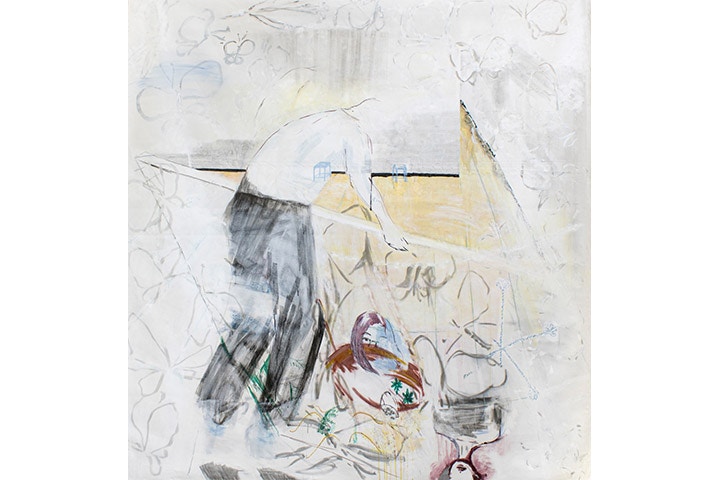
How has your practice developed whilst studying at the Slade School of Art?
At the beginning of my third year, I went on an exchange program at Malmö, Sweden. I started to question the necessity of my paintings. For example, what is the purpose of filling up a canvas; what kind of mannerism that I carry doesn’t belong to me. It introduced me to make paintings with more possibilities. I think in previous years at the Slade I felt somehow restricted by the things I could do about painting, I was timid and confused, probably because I wasn’t aware of the potential, the spaces and dialogue that painting could produce and generate.
There is a wonderful sense of economy in the application of paint in your works. You combine purposeful, expressive brush marks with large bleached out areas. How do you decide what to leave out and what to keep in?
I don’t see the point of filling up a whole canvas with colour so I leave most of the area as it is, however in some paintings, I use a large quantity of white paint to erase marks I’ve made to create blank spaces, non-disturbed. And you are right, the brush marks are purposeful, they are required to be there, I want them all to be precise.
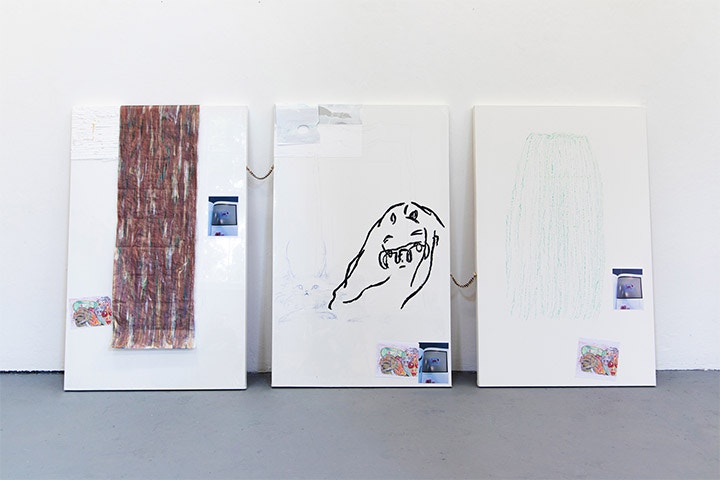
Alongside traditional painting materials, in some works you combine these with mixed-media elements. What informs your decisions when choosing your materials for a work, and how do you feel the mixed media enhances the paintings?
The triptych that was laying on the floor, I actually bought the canvases from Cass Art, it’s hard to see in the photos but the first two canvas still has their original plastic sleeves wrapped around them, it’s almost a ready-made. Then I added some painting related materials on the canvases, for example, half of a tear-off paper palette and strips of dried-up white acrylic paints. I used these two materials to cover up the Winsor & Newton logo on the top left canvas.
I’ve used some custom lens cloths on my paintings, the material is very fascinating for me because by using it to clean my glasses, it can literally help me to see better. I hope the materials indicate the medium of painting, or the work of painters, as ordinary as it is.
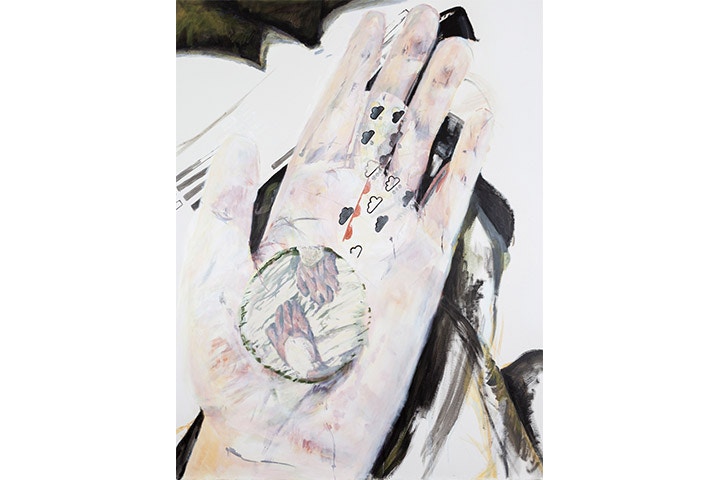
And what do you have planned for the prize?
Not sure yet, probably some colourful tapes. They are so nice.
What are your go to materials, are there any brands that you turn to?
I have been using Cobra water mixable oil colour for a long time and I love it. Its quality is between oil paint and acrylic, it helped me to create washed-out, subtle layers on canvas while maintaining very good colour vibrancy.
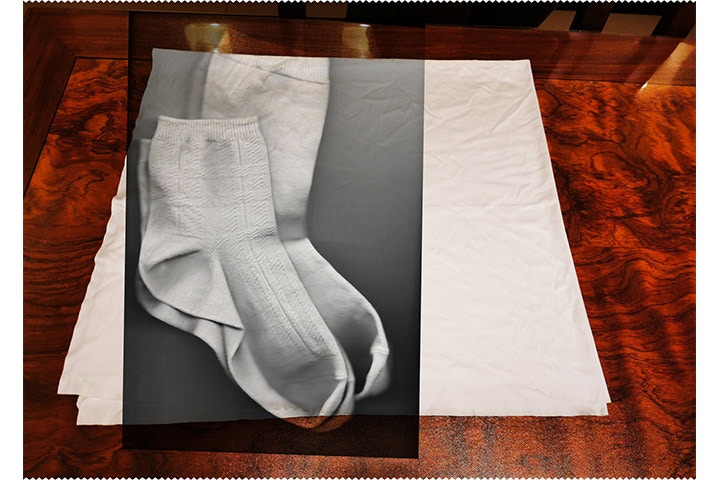
And finally, what’s next on the horizon for you?
I am planning to rent a studio and keep making work. My Instagram is @a.d.foreal, I usually update upcoming show’s details there. Thank you!
See more of LuHe’s work on the Slade School of Fine Art’s Graduate Showcase.
Noah El-Hachem
Hi Noah! Congratulations on winning the Cass Art prize! Could you introduce yourself and your practice?
Hey, Thank you so much for the prize, I really appreciate it! I work with oil paint and usually like to paint large portraits. I grew up in Germany but ended up doing a 3 year BFA in London. After graduation I want to be at home in Germany for a while and just paint and maybe start looking for a studio space!
Are there any other artists who have particularly inspired you and had an influence on your work?
The artists that inspired me most during my time at Slade were the artists that I got to work alongside of, my favorite being Okiki Akinfe and Moza Almazrouei.
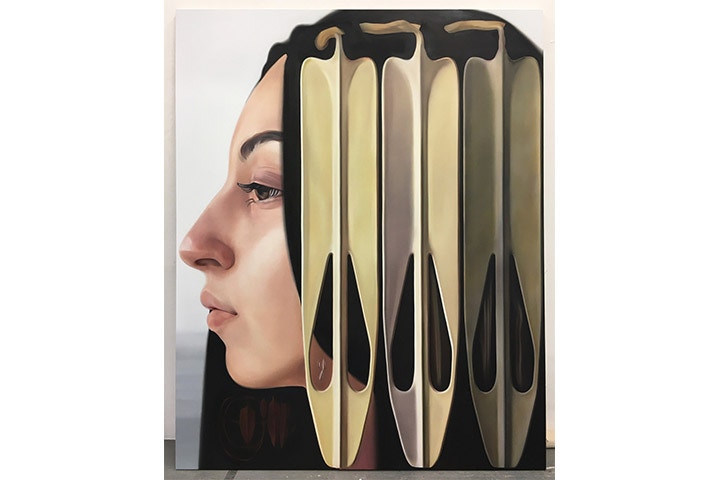
How has your practice developed whilst studying at the Slade School of Art?
I think my work itself didn’t change at all but painting definitely became a more sophisticated process and I learned to sometimes not remain fixing little problems for too long and to move on instead.
Your work depicts large scale portraits alongside objects inspired by natural forms such as leaves. What is the relationship between the two subjects in your painting?
The relationship is a very unintentional sort of side effect of adding an object to a portrait and giving both components the same type of attention. Over the years I repeated leaves so many times that the process became automatic and the imagery more geometric. I actually use them to decorate the portrait but I can normally find meaning for them after time and reflecting.
Your paintings have interesting compositions, can you talk a little about how important the composition is in your work and how you make your compositional choices?
Thank you for asking this because the composition is the most fun part for me. It’s kind of a purely instinctive weighing of objects and balancing out. I hate when things are top heavy!
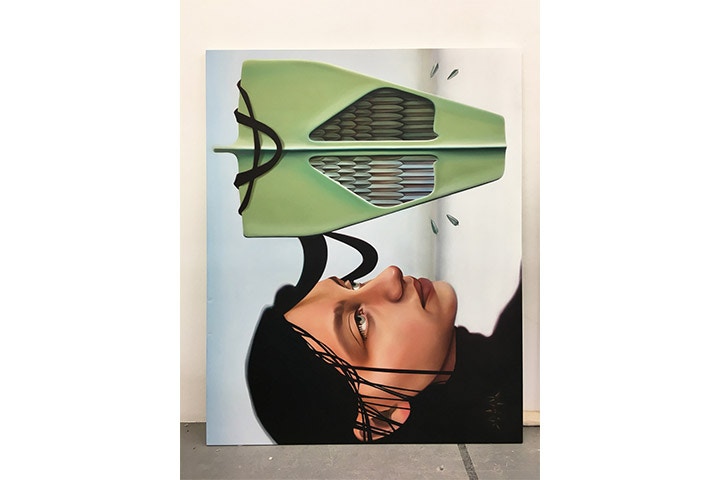
And what do you have planned for the prize?
I think I will use the prize to buy really soft paintbrushes because they are always one of the more expensive things and it will be nice to just get what I want.
What are your go to materials, are there any brands that you turn to?
I really like Zest-it because it is less toxic than other solvents and it works just the same!
And finally, what’s next on the horizon for you?
My next project is to turn my degree show works into a series and expand it until I have around 5 or 6 paintings in the same size. I think it will keep me busy for the next couple of months! My Instagram is @noahelhachem . Thanks again for the prize!
See more of Noah’s work on the Slade School of Fine Art’s Graduate Showcase.
Azeri Aghayeva
Hi Azeri! Congratulations on winning the Cass Art prize! Could you introduce yourself and your practice?
Thank you, I’m honoured! My name is Azeri and I recently graduated from the BFA course at the Slade. I work in predominantly 2-dimensional mediums such as print-making, painting and photography, creating an arena in which, for a moment objects and people exchange roles, the perspective is collapsed by a juxtaposing perspective, the light sources and shadows betray each other, and chaos ensues often all in one room whilst the dormant world outside it watches. I like to create a microcosm where the subject is at once very real and also not true.
Are there any other artists who have particularly inspired you and had an influence on your work?
I’m particularly inspired by works in which the subject quivers between being something and simultaneously nothing at all. For example 15th/16th century Islamic artists painted a one-dimensional world devoid of depth and light in response to the demand for work that showed human form whilst their clerics forebode naturalistic depiction. Niko Pirosmani made up creatures in an attempt to depict real animals he had never seen, but heard of. Krzysztof Bednarski produced countless Moby Dick sculptures in his fictional pursuit of the literary whale.
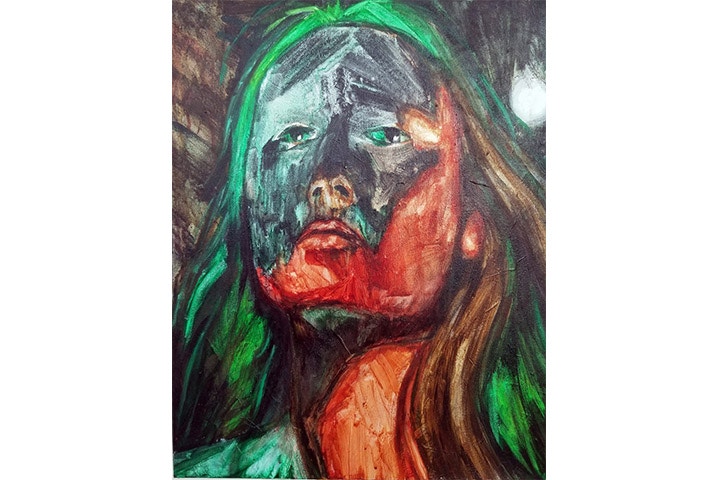
How has your practice developed whilst studying at the Slade School of Art?
When I joined the Slade I didn’t know how to express my work in words or look at art with a critical eye, the western fine art world was one that I found alienating especially carrying a middle eastern lens towards art. The Slade helped me to find my artistic identity and confidence whilst bridging the gap between my own background and the fine art world.
Your work is based on a conspiracy theory you created yourself, that films are used by the government to distract us from our banal lives by exchanging them with the many emotionally charged, eventful ones on screen. What made you develop this theory and how have you incorporated it in your work?
I can’t call it my own, I’m sure there are many who have conspired this before me. For me, it’s a good way to cut a conversation dead about movies, since I can't stand watching them. Over the lockdown I started watching films, and ironically started to believe my own lie. In desperation I began eating up my own conspiracy to satiate my unfulfilled life that was squeezed dry by the hands of a pandemic, in turn living the lives of the unreal. I watched classics; Guy Ritchie, Gaspar Noe, Stanley Kubrick, Wes Anderson, Peter Greenaway, and painted small compositions, as one would doodle whilst on the phone. It became my aid to watching films, and slowly the films became an aid for me to paint, because they gave me so much that life couldn’t in the height of the pandemic.

There’s a dynamic application of paint in your work, with thin washes of colour, areas of impasto and areas scraped away. Could you talk us through your process, how much of this is planned and how much is intuitive?
Most of the time painting feels like subtraction for me. There is always a push and pull of information in the painting, how much you’re willing to give and take. I usually plan so much in advance that when the painting starts there's a lot on the canvas, and halfway through I hit a wall which is when intuition takes over and the subtraction occurs; scraping layers, washing things out, covering up parts with impasto. I always come to the same realisation, that planning doesn’t work for me, but simultaneously the failure of the planning is such an important part of the process.
And what do you have planned for the prize?
I look forward to using my airbrush a lot more this year as I have only scraped the surface with this medium so I plan to experiment with mediums, airbrush maintenance and acrylic colours, and also look forward to investing in some stretcher bars as I can rarely afford them.
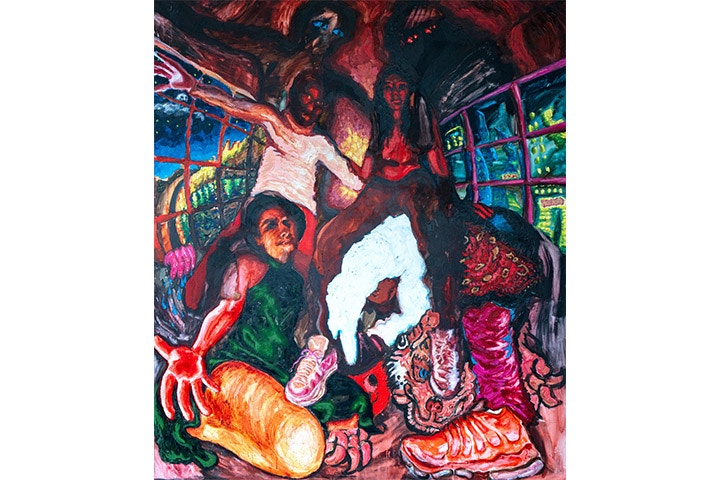
What are your go to materials, are there any brands that you turn to?
People seem to think that the best thing to gift an artist is art materials, and one day I was given a liquitex heavy body set of 12 which sat in my inventory for a while. I decided to start painting using the colours I would never use, from this pre-selected palette. Now I go straight to the acrylic aisle and gift myself the colours I find the ‘ugliest’ from Daler Rowney, Liquitex, Golden.
And finally, what’s next on the horizon for you?
I look forward to being a part of the Bloomsbury festival this Autumn, where I will have my first solo show (if covid permits), details of which will be shared closer to the time. You can find me on Instagram @azeri.sarah and you can see more of my work at https://www.azeriaghayeva.com.
See more of Azeri’s work on the Slade School of Fine Art’s Graduate Showcase.
Emily Webb
Hi Emily! Congratulations on winning the Cass Art prize! Could you introduce yourself and your practice?
Thanks! I'm Emily and I'm from London. I'll be staying here for a while after graduation to study at the Warburg Institute. My paintings use symbols a lot; they are a jumble of symbols that you can trace from painting to painting, mixed in with different narratives. It's the symbols that I want to keep studying, at the Warburg.
Are there any other artists who have particularly inspired you and had an influence on your work?
I really like Suellen Rocca and Martin Wong. I like painters whose work looks like diagrams and who impose their own logic on the work very explicitly. Paintings where the main concern isn't necessarily the paint.
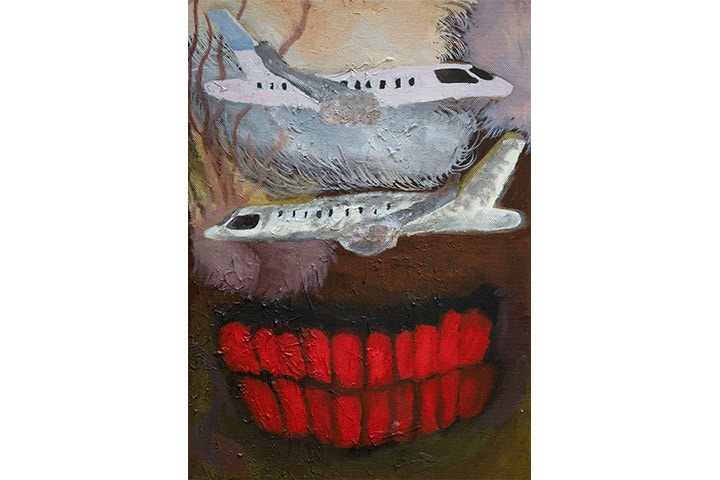
How has your practice developed whilst studying at the Slade School of Art?
My work has been kind of all over the place in the past four years, which I'm glad of. Art school can be a strange place to make art - it's like four years in a big bubble. It's only this last year away from the Slade with covid that I've started to figure out how to articulate the things I want to in my work.
Your paintings sit somewhere between abstraction and figuration, with colourful motifs and figures portrayed on abstracted or patterned backgrounds. Can you tell us about the narratives in your work and what significance the shapes and motifs have?
I think I'm more interested in the subject of the paintings, not so much the physical processes of how they came about. I didn't know how to use oil paints for a while so I just trust it to do what it needs to do. I'm not so interested in painting figures, and by leaving out faces or heads it makes them feel more like objects. I paint a lot of planes and try to reinforce certain things as symbols throughout all the works, threading them together. It goes back to what I said earlier about Suellen Rocca and Martin Wong.
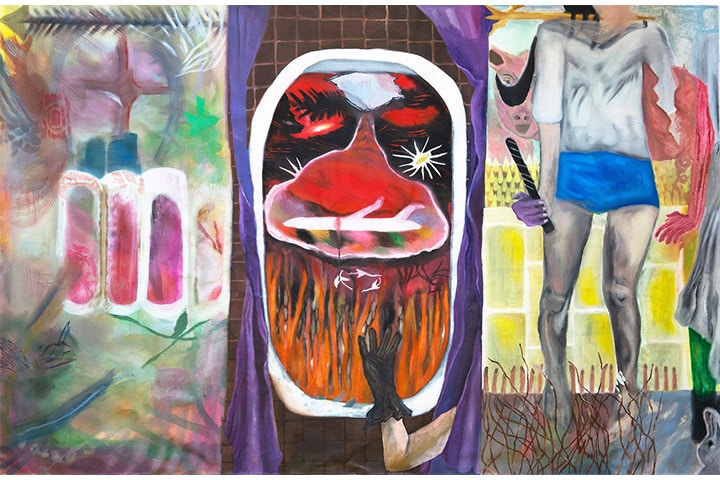
Could you talk us through your process, how do you create a painting from concept to completion?
This year I've started painting on these small, A4-ish sized canvasses. These have been the backbone of my work this year, and I'll do them constantly whilst working on larger paintings that take more time. The small ones vary from being quick sketches to more fleshed out works; the canvasses are cheap too so you can cycle through lots of ideas without thinking too much. They've given me a totally different understanding of colour and allowed me to try out things I can carry over to the big works. As for the larger works though, they're a bit more slippery... I usually start with a rough idea in my head, but I won't really know what it'll look like until it's done.
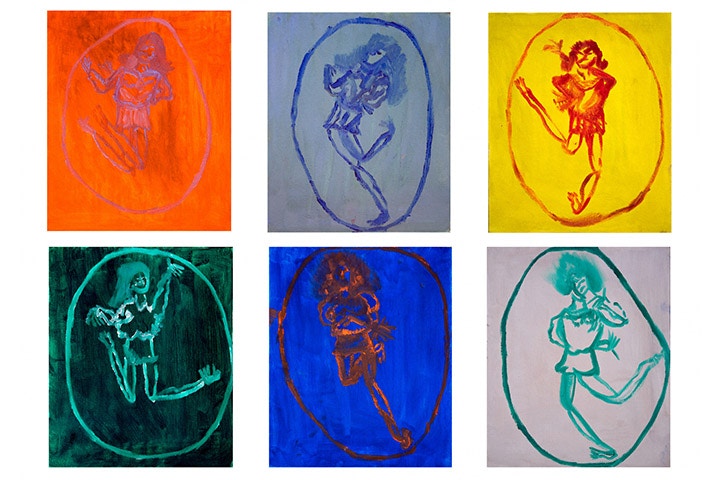
And what do you have planned for the prize?
I want to get something sparkly and expensive I wouldn't normally be able to buy. I could get two tubes of Michael Harding Lapis Lazuli! But what I really want is the big set of 120 Faber-Castell Polychromos pencils. Those pencils are so good.
What are your go to materials, are there any brands that you turn to?
I usually have two big tubes of Seawhite oil paints - one black and one white. For my colours, I've had a set of 60ml Michael Harding paints that have somehow lasted me over a year. I use a lot of Michael Harding Beeswax Paste too.
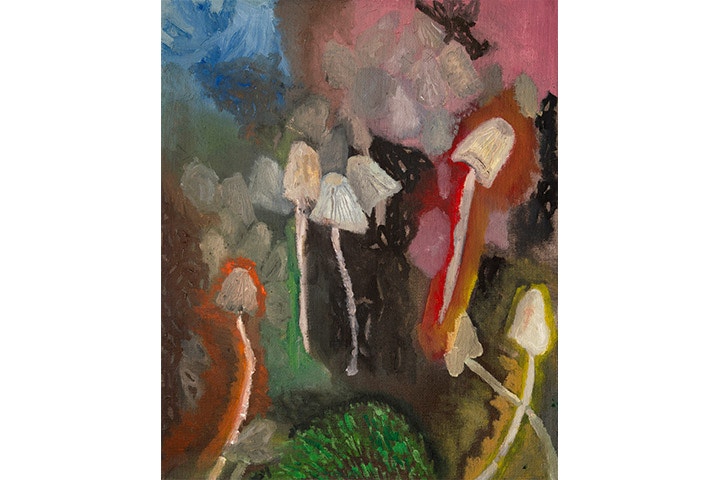
And finally, what’s next on the horizon for you?
I'm not sure...I might be painting a car.
See more of Emily’s work on the Slade School of Fine Art’s Graduate Showcase.
FEELING INSPIRED?
EXPLORE THE SLADE SCHOOL OF FINE ART DEGREE SHOWCASE 2020 - BA/BFA
Shop in-store or online for everything you need. Don't forget to hashtag #cassart on social media to show us your creations.

